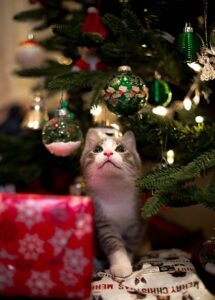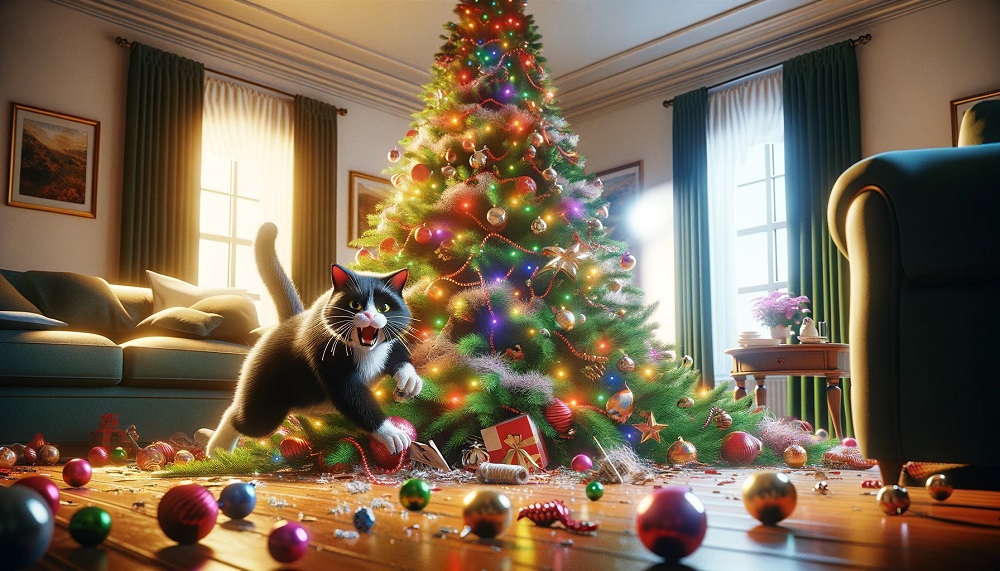Decorating for the holidays is supposed to be magical, not a daily game of “how did the tree fall over again?” If you’re a cat owner, you already know that putting up a Christmas tree is basically setting up a glittery jungle gym in your living room. Fortunately, with a little planning and a few clever tricks, you can keep both your tree and your curious cat safe through the holiday season.
Here’s how to enjoy festive cheer without the toppling, chewing, and ornament theft that often comes with it.
Why Cats Are Drawn to Christmas Trees
Before we dive into prevention, it helps to understand why your cat is acting like the tree is their new full-time job.
Cats are naturally curious and love high places. A tall, shiny, fragrant object suddenly appearing in the middle of the living room? That’s like dropping a theme park in their territory.
The tree smells interesting, the branches are climbable, and the dangling ornaments are clearly toys sent from the heavens. In other words, your cat isn’t misbehaving. They’re doing what cats do best: investigating, climbing, and swatting.
Choose the Right Tree (Yes, It Matters)
Let’s start with the foundation. Not all Christmas trees are equally cat-friendly.
Artificial Trees
Artificial trees tend to be safer for cats. They don’t have sap, they don’t shed needles, and they’re less tempting to chew. Bonus: they’re also reusable and usually sturdier.
If you go this route, choose one with hinged branches instead of hooked ones. Hinged branches lock into place and are less likely to fall off when your cat decides to launch a sneak attack.
Real Trees
If you prefer the real thing, opt for a fir or spruce instead of pine. Fir and spruce tend to have sturdier needles, which are less likely to fall off and be ingested. Pine needles are more brittle and can irritate or even puncture your cat’s digestive tract if eaten.
Make sure the tree stand is sturdy and secure. Use a wide, heavy base, and consider anchoring the tree to the wall or ceiling with clear fishing line to keep it upright.
Secure Your Tree Like a Pro
Even the best tree won’t stand a chance if it’s not properly secured.
- Use a heavy, tip-resistant tree stand
- Anchor the tree to the wall or ceiling with clear fishing line or strong twine
- Avoid placing the tree near furniture that your cat can use as a launchpad
- Skip the tree skirt if your cat sees it as a nap zone or something to burrow under
These small adjustments can make the difference between a peaceful holiday and a daily disaster.
Go Light on the Lights

Twinkling lights are beautiful to you and absolutely hypnotic to your cat. That’s a dangerous combo.
- Use cord protectors or hide wires behind furniture
- Secure the light strands tightly to the branches
- Unplug lights when you’re not home or when you go to bed
- Skip blinking settings if your cat is particularly fixated on them
Avoid using lights on the lower branches altogether if your cat is a known wire chewer. There’s nothing festive about a trip to the emergency vet.
Be Strategic With Your Ornaments
Ornaments are one of the biggest hazards, so this is where you want to get clever.
- No fragile glass ornaments within paw’s reach
- Skip tinsel and ribbon, which can be deadly if swallowed
- Avoid hooks on low-hanging ornaments. Use twist ties or string instead
- No candy canes, as peppermint is not safe for cats
- Place the most tempting decorations up high and keep the bottom branches bare or boring
Bonus tip: sprinkle a little citrus-scented spray on the lower branches. Most cats hate the smell, and it might keep their curiosity at bay.
Keep the Water Covered
If you’re using a real tree, your cat will probably treat the water at the base like a holiday punch bowl.
Tree water often contains sap and sometimes additives that are toxic to cats. Even plain water can become a breeding ground for bacteria.
To keep things safe:
- Cover the base with a tree skirt they can’t easily move
- Use aluminum foil or double-sided tape around the base to discourage snooping
- Never add preservatives or chemicals to the tree water
If your cat is extra determined, block off access to the base with a barrier like a baby gate or a decorative fence.
Give Them Their Own Holiday Distractions
Sometimes the best way to protect the tree is to give your cat something better to play with.
- Set up a cat tree nearby so they have something else to climb
- Offer holiday-themed cat toys with bells, feathers, or catnip
- Give them cardboard boxes to explore, especially wrapped like presents
Redirecting their attention is often more effective than trying to stop their curiosity completely.

This is what we would do if Mom and Dad let us play with the Christmas tree. #CatChristmas #ThisIsWhyWeCantHaveNiceThings
Winston & Joey
Consider a Tree-Free Option
If your cat turns into a flying ninja every December, it might be time to rethink the traditional tree altogether.
Consider these creative alternatives:
- A wall-mounted tree made of wood or fabric
- A tabletop tree placed out of reach
- A tree-shaped bookshelf decorated with safe items
You can still make your space feel festive without sacrificing your sanity or your cat’s safety.
Final Thoughts
Cats and Christmas trees can absolutely coexist if you plan ahead. The key is to think like your cat: if it sparkles, dangles, or smells weird, it’s going to be investigated. Probably with teeth. Maybe with claws.
But with the right tree, a secure setup, some strategic decorating, and a few clever distractions, you can enjoy all the magic of the season without worrying about your tree toppling over for the third time before New Year’s.
Let the lights twinkle, the ornaments sparkle, and your cat stay happily out of the tree.
Sources:
– Holiday Hazards | ASPCA https://www.aspca.org/news/holiday-hazards-your-pets
– Christmas Tree Safety Tips | PetMD https://www.petmd.com/cat/seasonal/christmas-tree-safety-cats
– Cats and Holiday Trees | VCA Hospitals https://vcahospitals.com/know-your-pet/christmas-tree-safety-for-cats
– Artificial vs Real Tree: What’s Safer for Pets? | The Spruce https://www.thespruce.com/real-vs-artificial-christmas-trees-4160918
Recent Posts
Your Cat Might Be a Furry Little Healer… or at Least a Fuzzy Alarm System If you’ve ever had your cat suddenly become extra clingy when you’re under the weather, you’re not alone. From...
Cats are experts at hiding things, socks under furniture, their disdain for your playlist, and, unfortunately, symptoms of illness. In the wild, showing weakness could make them a target, so even...


